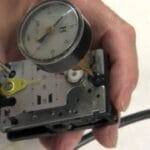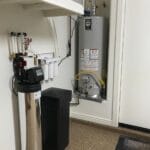The exhaust on a Generac generator is typically located on the engine’s side. It’s designed for safe and efficient expulsion of gases.
Generac generators, known for their reliability and power, are a popular choice for both home and commercial use. Ensuring the smooth operation of these machines involves understanding their design, including the exhaust system. The exhaust system plays a crucial role in directing harmful gases away from the generator and its users, maintaining a safe environment.
Whether you’re using a Generac generator for emergency power backup or as a primary power source, knowing its layout, especially the exhaust location, is essential. This knowledge not only aids in proper maintenance but also ensures safe operation. Generac’s thoughtful design, which includes the strategic placement of the exhaust, underscores their commitment to user safety and product efficiency.
Introduction To Generac Generators
Generac generators stand as leaders in power generation.
They provide reliable energy solutions for homes and businesses.
These generators are known for durability, efficiency, and convenience.
Popularity And Usage
Generac holds a top spot in the generator market.
They serve various sectors, including residential, commercial, and industrial.
- Emergency power for homes
- Business operations continuity
- Industrial backup power
Basic Components
Generac generators consist of several key parts.
| Component | Function |
|---|---|
| Engine | Powers the generator |
| Alternator | Generates electricity |
| Fuel System | Stores and supplies fuel |
| Voltage Regulator | Controls electricity output |
| Cooling and Exhaust Systems | Maintains temperature and vents fumes |
| Battery Charger | Keeps the battery charged |
| Control Panel | Operates the generator |
Each part is crucial for the generator’s optimal function.
Locating The Exhaust System
When maintaining or using a Generac generator, it’s crucial to know about the exhaust system. This part helps direct harmful gases away from the generator and the user. Understanding the exhaust’s location and how to safely inspect it ensures proper generator function and user safety.
Visual Inspection
A visual check is the first step in locating the exhaust on a Generac generator. Look for a pipe or vent typically at the generator’s side or back. This component is often made of metal and may have heat shielding. It’s designed to withstand high temperatures. If the generator is in a housing, the exhaust might connect to a larger vent pipe. This directs the gases outside the housing or building.
Safety Precautions
Safety is paramount when dealing with a generator’s exhaust. Always ensure the generator is off and cool before inspecting. Wear gloves and eye protection. Keep the area well-ventilated. Be aware of carbon monoxide risks. Never operate the generator in an enclosed space. Regular checks prevent blockages and leaks, which can be hazardous.
- Turn off the generator.
- Wait for it to cool down.
- Use gloves and protective eyewear.
- Inspect in a ventilated area.
- Check for blockages or leaks.
Design Aspects Of Generac Generator Exhaust
The Generac generator exhaust is key to its operation. Its design affects performance and safety. Let’s explore its construction and functionality.
Construction
Generac generators feature a robust exhaust system. Made from high-quality materials, it withstands high temperatures and corrosion. The exhaust’s heavy-duty steel ensures durability. This makes Generac generators reliable for long-term use.
Functionality
The exhaust system’s main job is to direct harmful gases away from the generator. It keeps users and the environment safe. A well-designed exhaust reduces noise levels. It also improves engine efficiency. Generac generators thus offer quiet operation and fuel economy.

Credit: m.youtube.com
Types Of Generac Generators
Understanding the Types of Generac Generators is key. Generac offers two main types: Portable and Standby. Each serves a unique purpose. Let’s explore these options.
Portable Models
Portable Generac Generators are great for on-the-go power. They are light and easy to move. You can use them for camping, job sites, or emergencies. Here are some key features:
- They come in various sizes and power levels.
- Easy to start and use.
- Run on gas or diesel.
Standby Models
Standby Generac Generators are for home or business. They start automatically during a power outage. This means you always have power. Here’s why they stand out:
- They install outside your home.
- Run on natural gas or liquid propane.
- Power your whole house or just essential items.
Maintenance Of The Exhaust System
Maintaining the exhaust system of your Generac Generator is key. It keeps the generator running smoothly and safely. Let’s dive into how you can take care of it with routine checks and cleaning procedures.
Routine Checks
Regular checks ensure the exhaust system works well. Follow these steps:
- Inspect the exhaust for leaks or damage.
- Check for rust or corrosion.
- Ensure all connections are tight.
- Listen for unusual noises when the generator runs.
Cleaning Procedures
Cleaning the exhaust system is straightforward. Follow these tips:
- Turn off the generator and let it cool.
- Remove any debris or dirt from the exhaust area.
- Use a soft brush to clean around the exhaust.
- If needed, apply a mild detergent for tough grime.
- Rinse with water and dry completely before restarting the generator.
Common Issues With Exhaust Systems
Understanding your Generac generator’s exhaust system is crucial. A well-functioning exhaust ensures safety and efficiency. Yet, common issues can arise. Let’s explore these problems and their impacts.
Leakage Problems
Generac generators are robust, but exhaust leaks do occur. Leaks can lead to harmful gases escaping. This poses risks to health and the environment. Regular checks can prevent these issues.
- Inspect for cracks or holes
- Check gaskets and seals
- Listen for unusual noises
Act promptly on finding leaks. Professional repair or replacement may be necessary.
Blockage Concerns
Blockages in the exhaust can hinder generator performance. Debris, nests, or rust can restrict flow. This leads to overheating and reduced efficiency.
- Clear visible obstructions
- Use proper tools for cleaning
- Seek expert help for internal blockages
Maintenance is key to preventing blockages. Ensure regular cleaning and inspections.
Upgrading The Exhaust
Upgrading the exhaust on a Generac generator improves performance. Owners often overlook this crucial aspect. An enhanced exhaust system boosts efficiency and reduces noise. Let’s explore the options and benefits.
Aftermarket Options
Generac generator owners have several aftermarket exhaust options. These range from simple slip-on silencers to complete exhaust kits.
- Slip-on silencers reduce noise levels.
- Stainless steel exhausts resist corrosion.
- High-flow catalytic converters enhance performance.
Choose based on your generator model and needs.
Benefits Of Upgrading
Upgrading the exhaust system offers tangible benefits.
| Benefit | Description |
|---|---|
| Improved Efficiency | Better exhaust flow increases engine efficiency. |
| Reduced Noise | An upgraded exhaust lowers the noise output. |
| Extended Lifespan | Quality materials prolong system life. |
| Environmental Impact | Enhanced systems emit fewer pollutants. |
Remember to select a compatible exhaust upgrade. This ensures optimal generator function.
Safety Tips When Handling Exhaust
Understanding where the exhaust is on your Generac generator is crucial. It’s important to handle generator exhaust safely to protect yourself and your environment. Below are key safety tips to consider when dealing with generator exhaust.
Proper Ventilation
Generators must operate outdoors to ensure proper ventilation. Never run a generator inside an enclosed space. Adequate airflow prevents dangerous gas build-up. Position generators so that exhaust fumes cannot enter homes or spaces where people gather.
Carbon Monoxide Hazards
- Carbon monoxide (CO) is a colorless, odorless gas.
- Generators emit CO during operation.
- CO poisoning can be fatal.
- Install CO detectors near living areas.
- Know the symptoms of CO poisoning: dizziness, headaches, nausea, and fatigue.
- Ensure everyone knows to evacuate and call for help if detectors signal high CO levels.
Professional Assistance And Services
Finding the exhaust on a Generac generator is crucial for safe operation. Professional assistance ensures proper maintenance and service. This guide helps you recognize when to seek expert help and how to select a reliable service provider.
When To Seek Help
Generac generator owners should consult professionals in these situations:
- Unusual noises: Knocking or rattling from the generator.
- Visible damage: Cracks or holes near the exhaust area.
- Performance issues: Generator starts then stops or has trouble running.
- Regular maintenance: Annual check-ups preserve generator longevity.
Choosing A Service Provider
Selecting the right service provider is key. Look for these qualities:
| Criteria | Details |
|---|---|
| Experience | Years of working with Generac generators |
| Reputation | Positive feedback from clients |
| Certification | Technicians certified by Generac |
| Availability | Responsive and available for emergencies |

Credit: diy.stackexchange.com

Credit: www.youtube.com
Frequently Asked Questions
Where Is The Generac Generator Exhaust Located?
The exhaust on a Generac generator is typically located on the side or back, away from doors and windows to ensure safety and proper ventilation.
Can I Modify My Generac Exhaust System?
Modifying the exhaust system of a Generac generator is not recommended as it can void the warranty and pose safety hazards.
What Are Common Generac Exhaust Issues?
Common issues include blockages, leaks, and corrosion, which can affect performance and safety if not addressed promptly.
How Often Should Generac Exhaust Be Inspected?
Generac recommends inspecting the exhaust system annually or according to the maintenance schedule in your owner’s manual for optimal safety and performance.
Is Generac Generator Exhaust Safe Around Pets?
Generac generator exhaust emits carbon monoxide, which is dangerous for humans and pets; always ensure proper ventilation and keep pets away from operating units.
Conclusion
Understanding your Generac generator’s exhaust location is crucial for safe and efficient operation. It ensures proper ventilation and minimizes risks. Remember to consult your user manual for specifics and maintain clearances to prevent hazards. Keep up with regular maintenance, and your Generac will power through when needed most.
Stay powered up and safe!





